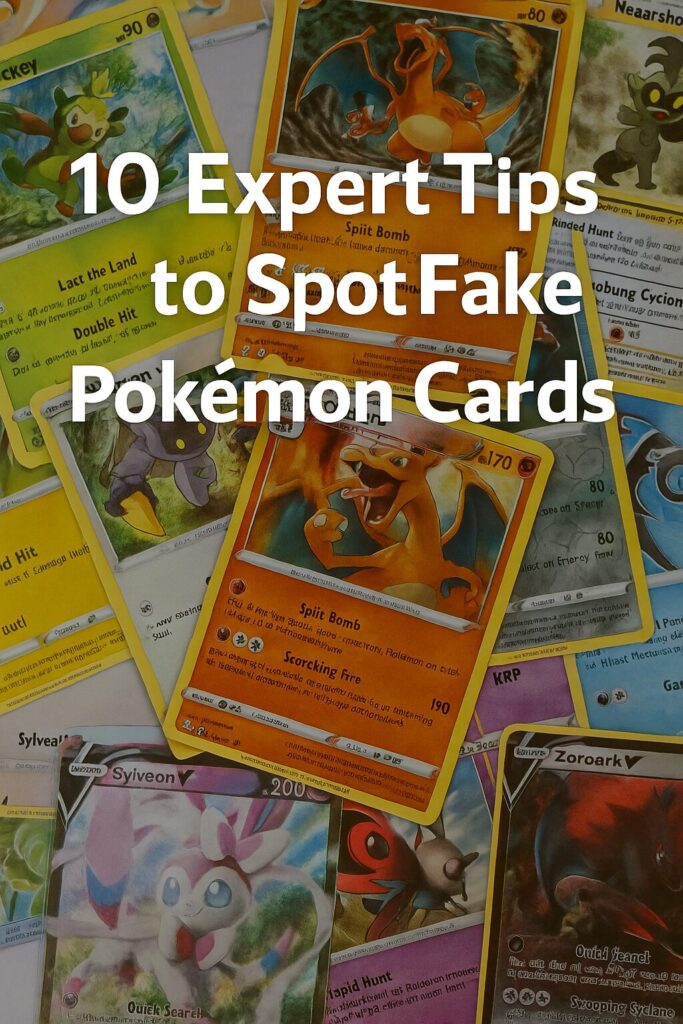
Want to spot fake Pokémon cards? This guide gives you clear, practical checks—print, texture, light test, and more—so you can confidently spot fake Pokémon cards before you buy, trade, or grade. Use these tips at shows, in shops, and online listings to protect your money and your collection.
Quick Answer (in 3 lines)
- Do the light test: real cards show a thin blue/black core; obvious light bleed usually means fake.
- Check print & fonts under zoom; look for dot patterns, fuzzy text, or wrong color tones.
- Feel the finish: authentic cards have a specific stiffness, snap, and surface texture.
10 Expert Tips to Spot Fake Pokémon Cards
1) Light Test (Blue/Black Core)
Hold a card against a bright light. Authentic Pokémon cards are made from layered stock with a dark core; light should not pass through easily. If light bleeds through the whole face, that’s a fast way to spot fake Pokémon cards.
2) Weigh & Flex (Card Stock “Snap”)
Gently flex the card—real cards spring back with a crisp snap and feel neither flimsy nor rubbery. Extremely thin, bendy, or plasticky cards are common tells when you’re trying to spot fake Pokémon cards.
3) Print Quality & Halftone Dots
Use your phone camera at 3–5× zoom. Authentic prints look sharp with consistent dot patterns; fakes often show grainy colors, jagged edges on text, or washed-out saturation. This alone helps you spot fake Pokémon cards quickly in online photos.
4) Fonts, Spacing, and Punctuation
Compare the name, HP, attack text, and energy symbols against a verified database (e.g., PokéBeach scans). Odd spacing, wrong quotation marks, or off-by-one kerning can help you spot fake Pokémon cards in seconds.
5) Set Symbols & Rarity Icons
Verify the set symbol, rarity (● ◆ ★), and numbering (e.g., 12/102). Misplaced icons, incorrect set pairings, or font mismatches are common in counterfeits—great ways to spot fake Pokémon cards without special tools.
6) Holo Pattern & Foil Placement
For holos, compare the holo pattern to known authentic patterns from that era. Fakes often have overly reflective, “oil-slick” foil or holo that bleeds outside the window. In modern cards, textured foils should align with art; misaligned texture can help you spot fake Pokémon cards.
7) Texture, Finish, and Edges
Run a clean finger along the edge—authentic cards have neat, uniform edges. The surface finish (matte vs. glossy) varies by set, but cheap gloss or sticky laminate is a red flag. High-quality texture is a strong tell when you spot fake Pokémon cards.
8) Color Accuracy (Backs & Fronts)
The back blue on real cards has a specific hue and soft gradient. Fakes skew too purple, too dark, or flat. On the front, compare yellow borders and reds in the logo. Color drift is a reliable way to spot fake Pokémon cards in pictures.
9) Serial & Promo Markers (Modern)
Check for modern features like stamped promo markers or etched textures on special releases. Missing or poorly aligned stamps can instantly help you spot fake Pokémon cards in exclusive products.
10) Cross-Check the Card Exists
Confirm that the exact card (name, set, number, rarity) actually exists. Counterfeits sometimes invent combinations that never released. A quick database search is a powerful method to spot fake Pokémon cards—especially for high-value listings.
Buying Safely (Online & In-Person)
- Ask for macro photos: corners, foil window, back color, and text close-ups.
- Compare with a known real card: keep a cheap common from the same era for side-by-side checks.
- Know the seller: look for established feedback, return policies, and transparent lighting in photos.
- Be wary of lots: large “vintage” bundles at too-good-to-be-true prices are often mixed with counterfeits.
When to Grade or Get a Second Opinion
For expensive singles, certification (PSA/CGC/BGS) adds confidence and preserves value. If you can’t conclusively spot fake Pokémon cards on your own, consult a reputable local shop or a grading pre-check service.
FAQ
Are misprints the same as fakes?
No. Misprints occur during legitimate production (ink errors, off-cuts). Fakes are unauthorized reproductions. Learn the difference so you can spot fake Pokémon cards without confusing them with factory errors.
Do counterfeiters copy holo textures accurately?
They try, but alignment and depth are usually wrong. Compare texture direction and edges closely—this helps collectors spot fake Pokémon cards even in newer sets.
What if only the card back looks “off”?
Card back color and gradient are among the best tells. If the blue tone, Poké Ball shading, or font looks wrong, you may already have enough to spot fake Pokémon cards confidently.
Are proxy cards considered fake?
Proxies are non-authentic placeholders—fine for casual play if everyone agrees, but they are not legal for trading as originals. Treat them as fakes when evaluating value.
Helpful Resources
- Bulbapedia: Card databases & set info
- PokéBeach Scans: High-quality card scans
- PSA Resources: Collecting & authentication basics
Explore More on AnswerNimbus
Want more collecting tips? Browse Collectibles for storage guides, valuation basics, and more methods to spot fake Pokémon cards with confidence.
AnswerNimbus is an online knowledge hub providing step-by-step guides, how-to fixes, and clear explanations across technology, home, collectibles, and everyday curiosities. Our mission is to make useful information easy to find, understand, and apply.
